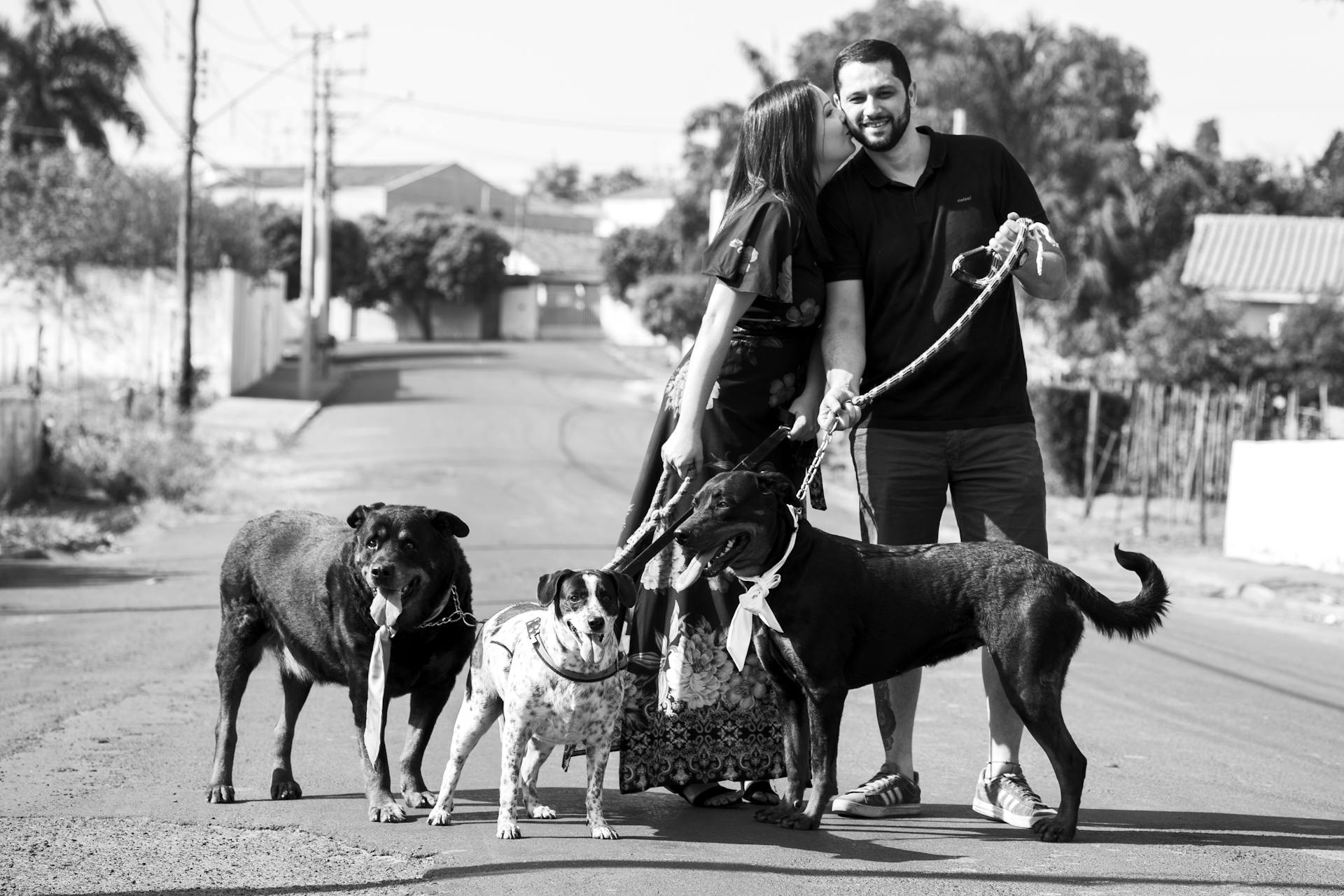
Dogs can catch the flu, just like humans do. In fact, dogs can contract the influenza virus from other infected dogs or even from their owners.
The flu in dogs is usually caused by the H3N8 or H3N2 viruses, which are highly contagious and can spread quickly through a pack or household.
Dogs showing symptoms of the flu may exhibit a runny nose, sneezing, coughing, and fever.
What You Need to Know
Dogs can get the flu, but it's not the same as the human flu virus. Canine influenza is caused by one of two different viruses – H3N2 or H3N8 – that originated from other animals.
The virus is highly contagious and spreads through droplets made by barking, sneezing, or coughing. It can also be spread by direct contact with contaminated surfaces.
Symptoms of canine flu include a cough, sneezing, runny nose, fever, lethargic behavior, lack of appetite, and difficulty breathing. These symptoms can be pretty scary to see in your furry friend.
Here are the main symptoms of canine flu:
- Coughing
- Sneezing
- Runny nose
- Fever
- Lethargic behavior
- Lack of appetite
- Difficulty breathing
Prevention and Vaccination
Minimizing your dog's exposure to other dogs is key to preventing the spread of canine flu. This can be achieved by keeping them out of close, confined quarters as much as possible, and ensuring they get enough rest to keep their immune system strong.
If you do need to board your dog or enroll them in puppy daycare, ask the facility about their cleaning schedule. You can also consider vaccinating your dog against canine flu, especially if they're frequently exposed to other dogs.
There are two strains of canine flu, H3N2 and H3N8, and a vaccine is available for both. The decision to vaccinate your dog depends on their lifestyle, but it's especially important for dogs that are in high-risk situations, such as those that frequent dog parks or kennels.
Here are some common-sense tips for preventing the spread of dog flu:
- Wash your hands with soap and water after touching other dogs.
- Change and wash your clothes after interacting with other dogs.
- Consider vaccinating your dog, especially if they're in high-risk situations.
- Keep hard surfaces sanitized.
- Stay away from dogs showing symptoms of dog flu, and avoid areas with reported breakouts.
It's worth noting that the CIV vaccine can't completely prevent the disease, but it may reduce the severity and duration of clinical signs associated with infection. This is especially important for at-risk dogs, and can help reduce the spread of outbreaks.
Diagnosis and Testing
Diagnosing canine influenza requires a bit more effort than just looking for symptoms. A diagnosis can't be made based on symptoms alone, as they can also be indicators of other respiratory illnesses.
Your veterinarian will take nasal swabs and serum samples to confirm a flu diagnosis. Swabs are used to detect the virus when dogs start coughing, while serum samples are used to detect CIV-specific antibodies in dogs that have been ill for more than 7 days.
For dogs that have been ill for fewer than 4 days, nasal and oral swabs can be collected and sent out for diagnostic testing at a laboratory that offers a validated PCR test for canine influenza. This test is considered the preferred test for diagnosing infection in the acute stage.
The most reliable way to diagnose dog flu is paired serologic testing on two blood samples – one taken during the first week of illness and the second taken 2 to 3 weeks later. This type of testing is considered the most reliable way to confirm canine influenza virus infection.
Explore further: What Are the Symptoms of a Dog with a Blockage?
Here are some common tests used to diagnose canine influenza:
- Polymerase chain reaction (PCR) testing for virus nucleic acid
- Serologic testing for antibodies against the virus
- Virus isolation
- Immunoassays to detect virus antigen
It's worth noting that serologic testing requires two serum samples, taken at different times, to be accurate. This can be a challenge, but it's the most reliable way to confirm canine influenza virus infection.
PCR testing is often used in the acute stage of the illness, as it's faster and can provide more accurate results. However, it's essential to collect samples within four days after the onset of clinical signs to minimize the chance of a false-negative result.
Treatment and Care
If your dog contracts canine influenza, the first step is to quarantine them for up to three weeks to prevent the spread of the virus.
Quarantine is crucial because canine flu is highly contagious and can be spread easily to other dogs. This means keeping your dog away from other dogs, including trips to the groomer or dog parks, and even contact with other dogs during walks and in kennels.
Broaden your view: How Is Kennel Cough Spread
You'll also want to provide your dog with plenty of rest, fluids, and possibly an anti-inflammatory to help them recover.
To prevent transmission of the virus, it's essential to follow proper hygiene practices, including thoroughly cleaning clothing, equipment, floors, and hands with soap and water after contact with any dog showing signs of respiratory illness.
Here's a quick rundown of the typical treatment plan for canine influenza:
- Fluids to manage dehydration
- Nutritional supplementation
- Antimicrobials to combat secondary bacterial infections/pneumonia
- Nebulization with saline solution and/or coupage to help loosen lower airway secretions
- Nonsteroidal anti-inflammatory medications as needed to reduce fever and inflammation
Keep in mind that most dogs will recover within 2-3 weeks, but secondary bacterial infections can take longer to clear up and may require additional testing and treatment.
Treating Your
Most cases of canine influenza are mild and self-limiting, with dogs recovering within two to three weeks. Good nutrition is always important, and your veterinarian may recommend a high-quality diet to help your dog recover.
Supportive care is recommended for dogs with more severe illness, which may include fluids to manage dehydration, nutritional supplementation, and antimicrobials to combat secondary bacterial infections or pneumonia.

To prevent transmission of the virus, dogs with H3N2 canine influenza need to be isolated for at least 21 days, and dogs with H3N8 canine influenza for at least seven days. It's essential to consult with your veterinarian to determine the best course of treatment.
Your veterinarian may prescribe an antibiotic and nutritional plan to help treat any secondary infections that may have arisen due to a weakened immune system. If your dog does not improve within 10 days, contact your veterinarian immediately.
Here are some essential steps to care for your dog with canine influenza:
- Quarantine your dog for up to three weeks to prevent the spread of the virus
- Keep your dog away from other dogs, including trips to the groomer or dog parks
- Clean clothing, equipment, floors, and hands with soap and water after contact with any dog with signs of respiratory illness
Treating Costs
Treating Costs can be a significant expense, but it's essential to consider the options. A dog flu vaccine can range between $30–$55, possibly higher depending on your location.
If you decide to visit the vet for an office visit, you can expect to pay a separate charge. This charge will vary depending on the services provided, such as examination or vaccine administration.
Signs & Symptoms
Dogs can catch the flu, and it's essential to know the signs and symptoms to take action quickly.
The symptoms of dog flu can range from mild to severe, and they can resemble other respiratory diseases, including kennel cough and distemper.
Common symptoms include a cough, sneezing, nasal discharge, runny eyes, fever, lethargy or lack of energy, difficulty breathing, and decreased or absent appetite.
Some dogs may not show any symptoms at all, but they can still be contagious.
The cough associated with dog flu can be either moist or dry and may last for 10 to 21 days.
In severe cases, dog flu can lead to pneumonia, which can be life-threatening without proper treatment.
Here are the common symptoms of dog flu:
- Coughing (either moist or dry)
- Sneezing
- Nasal discharge
- Runny eyes
- Fever
- Lethargy / lack of energy
- Difficulty breathing
- Decreased or absent appetite
Older dogs and dogs with heart or respiratory conditions are at a higher risk of developing complications from dog flu.
Brachycephalic breeds, such as Boston Terriers, Boxers, Pekingese, Pugs, and Shih Tzus, are also at higher risk due to their flat faces.
Contagion and Spread
Canine influenza, also known as dog flu, is highly contagious between dogs. Dogs who have become infected with the flu should be kept away from other dogs until they are no longer contagious.
CIV can survive on skin and hands for 12 hours, on clothing for 24 hours, and surfaces for up to 48 hours. This means that even if you wash your hands, you could still be carrying the virus on your skin or clothes.
Infected dogs are most contagious during the incubation period, which is about two to four days after contact with the virus. During this time, they can spread the virus to other dogs through respiratory secretions, contaminated objects, and even people who come into contact with them.
To prevent the spread of dog flu, good sanitary practices are essential. Here are some common-sense tips:
- Wash your hands with soap and water after touching other dogs.
- Change and wash your clothes after interacting with other dogs.
- Consider vaccinating your dog if they'll be in areas where there's a risk of contamination.
- Keep hard surfaces sanitized.
- Stay away from dogs showing symptoms of dog flu and areas with reported breakouts.
It's worth noting that there is no evidence that dog flu can be passed from dogs to humans or other animals. However, it's still important to take precautions to avoid spreading the virus to other dogs.
Recovery and Management
During your dog's recovery from canine influenza, it's essential to keep him hydrated by ensuring he's drinking plenty of fluids to prevent dehydration.
Make sure to quarantine your dog until he's no longer contagious, especially if you have multiple dogs at home.
To prevent other dogs from contracting the virus at the vet, it's best to remain outside or in the car until the vet is ready to see you.
You can also ask if there's a separate entrance you can use to avoid your dog coming into contact with other animals at the vet clinic.
General Information
Canine influenza is caused by two different influenza viruses – H3N2 or H3N8, which originated from other animals.
These viruses are highly contagious and can spread through droplets made by barking, sneezing, or coughing, as well as through direct contact with contaminated surfaces.
The symptoms of canine flu include coughing, sneezing, runny nose, fever, lethargic behavior, lack of appetite, and difficulty breathing.
Here are the common symptoms of canine flu:
- Coughing
- Sneezing
- Runny nose
- Fever
- Lethargic behavior
- Lack of appetite
- Difficulty breathing
Sources
- https://www.westfieldvetgroup.com/blog/2020/august/can-dogs-get-the-flu-yes-/
- https://www.smalldoorvet.com/learning-center/medical/dog-flu-canine-influenza
- https://www.fosterpetvet.com/services/dogs/blog/can-your-pet-get-flu-what-you-need-know-about-civ
- https://www.avma.org/resources-tools/animal-health-and-welfare/animal-health/canine-influenza-veterinary-resources
- https://vcahospitals.com/know-your-pet/canine-influenza-the-dog-flu
Featured Images: pexels.com


